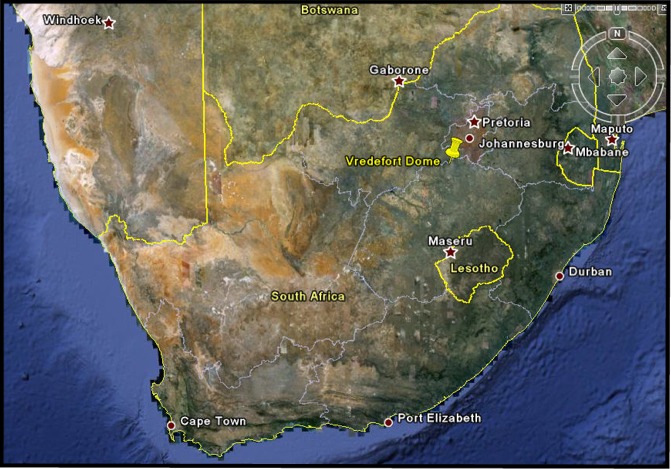|
|
News!(Previous news items can be found in the archive)
|
||||||||||
Overview over this website(For general information about Deelfontein and the Dome, scroll down) Dome Arts Retreat
Accommodation at DeelfonteinExperience peace and quiet far from the distractions of the city - tourist accommodation on the secluded farm Deelfontein, situated in the heart of the Dome. Accommodation options include
ActivitiesDeelfontein offers a variety of exciting outdoor activities:
Deelfontein ObservatoryEquipped with a 12" Schmidt-Cassegrain-telescope and several other telescopes, the observatory at Deelfontein offers research opportunities and stargazing outings. Prior booking for stargazing (at least 30 days in advance) is essential, and use of the telescopes is possible only under expert supervision or after training.Deelfontein Veteran Car MuseumThe collection of oldtimer cars include a Pontiac (1931), De Soto Airflow (1934), Mercedes Benz (1959), Jeep Wagoneer (1964), Ford Thames Trader (1961) and a Fordson Dexta (1961). The museum building is under construction.Farming ActivitiesDeelfontein covers 170 hectares bushveld in the Vredefort Dome. Herds of indiginous goats, Damara sheep and Nguni cattle are held. Animals are available from time to time. Raw honey from beekeeping on the farm is offered for sale.
|
|||||||||||
The farm DeelfonteinDeelfontein, 170ha bergland covered with near-pristine bushveld, is located in the Vredefort Dome, a geologically unique formation about 120 km southwest of Johannesburg on both sides of the Vaal river. The farm lies on the southern side of the river between two of the concentric ridges typical of the Dome. The height above sea level varies between 1400 and 1600 metres, and the climate is continental. In the wet and hot but never blistering summers, the Dome is transformed in a lush and green paradise. Characteristic for the winter, dry and mostly sunny, are the large daily temperature differences, from freezing at night to comfortably warm during the day. In the fertile and deep soils of the valley, maize and fruit were produced. Since many years, however, the old fields have been lying idle and are slowly invaded by the indigenous grasses and thorn trees. The stone ridges are covered with the tree veld characteristic of the Dome, in which Acacia caffra dominates. Various animals occur naturally: Small mammals such as hares and porcupines, antilope species such as duiker, hartebeest, reedbuck and kudu, as well as predators like lynx and leopard. Due to the limited agricultural potential of the area, nature has remained largely intact in the Dome. Most of the owners are keenly aware of the threats to the environment and the land use tends toward eco-tourism, ensuring a sustainable future for the area. Various game farms and tourist enterprises offer outdoor activities such as bow hunting, hiking, rowing and adventures. Also at Deelfontein, activities are limited to those that are environmentally friendly, such as hiking, and the necessary development is done using the latest green technology. However, the beautiful natural surroundings, the quietness and the seclusion have more than just tourism potential. It also offers ideal circumstances for effective and concentrated learning far away from the distractions of the city. This potential is realized in the courses offered at the Dome Arts Centre at Deelfontein.
|
|
||||||||||
The Vredefort DomeA unique geological formation: The name Vredefort
Dome refers to the town Vredefort, founded in 1876 after
the first Boer War. The apparently obvious motivation for the second part
of the name is only visible from space -- then the
sickle-shaped concentric ridges centred around Vredefort
become visible. However, the word Dome really refers to
the dome-like formation under the surface of the earth. After the continuous erosion of the past 2200 million years, the once high mountain at the centre of the impact site has been totally flattened. However, the different erosion rates of the various sedimentary layers, now standing almost vertically, resulted in the structure visible today. This is why the search for a big hole or the meteorite itself is in vain. On the upper satellite image, the concentric ridges of the Dome are clearly visible. The second photo shows the connection between the gold mines of the Witwatersrand, visible as the white spots of the mine dumps, and the centre of the impact, marked with a V for Vredefort. Further information about the Dome is available on the following two websites www.geo.tu-freiberg.de and www.hartrao.ac.za
The Dome Meteorite Park: nature conservation in the DomeWith the exception of about 200 ha of state land, the total surface area of the Dome, about 30 000 ha, is private property. Some owners occupy their land in unbroken descent from the time of the Great Trek. In the second half of the twentieth century, businessmen and professionals acquired land in the Dome as weekend getaway farms. In recent times, the area was discovered by the tourist industry. This was to be expected, since the natural beauty and the proximity to the greater Johannesburg metropolitan area predestines it to become a valuable outdoor recreational area for almost a third of South Africa's population. Since then, a third generation of landowner has bought land in the Dome for tourist developments. This has caused land prices to rise dramatically. Conversely, the high prices forces any buyer to develop in order to recoup his investment, increasing the pressure of development on the area. Anticipating this development, a far-sighted group of conservation minded owners in 1997 formed a conservancy with the aim of proclaiming the area as a nature reserve. Together with the two parks boards, they applied to UNESCO for listing the Dome as a World Nature Heritage Site. At its convention in Durban in July 2005, UNESCO complied. Since then, numerous studies were undertaken to compile a management plan for the Dome. Newly reorganised as a Section 21 company known as the Dome Meteorite Park, the conservancy engages in intensive negotiations with government and the two landowner's associations to have the area proclaimed as a South African heritage site and to appoint an appropriate management body -- always with the conservation of the natural resources as guideline.
|
|||||||||||

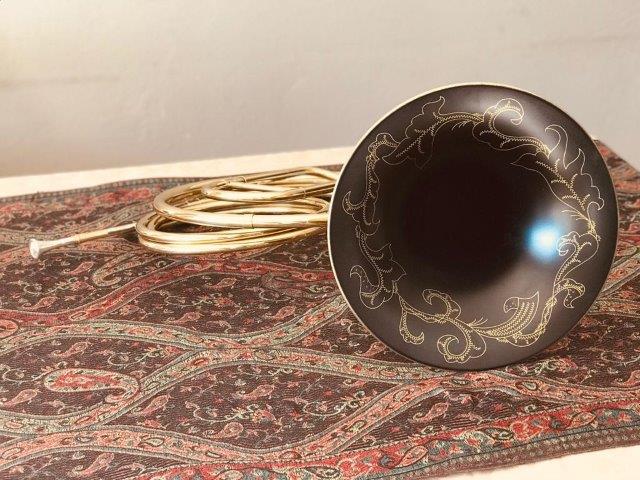
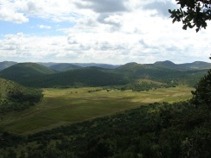
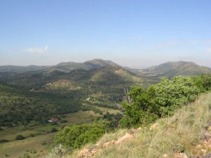
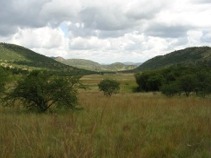
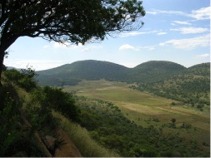
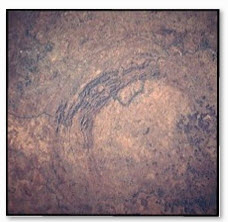 The cause of this geological formation is an impact
of huge dimensions. About 2 020 million years ago (by
comparison: the earth is 4000 million years old), an
asteroid of roughly 10 km in diameter hit the earth
where Vredefort lies today, penetrating up to 17 km into
the mantle. The energy set free by the collision caused
a crater of about 300 km in diameter and a rebound cone
of about 90 km in diameter. The layers of sediment, up
till then in a horizontal position, were tilted upward
by the rebound to an angle of 30 degrees beyond the
vertical. These layers today form the characteristic
concentric ridges of the Dome.
The cause of this geological formation is an impact
of huge dimensions. About 2 020 million years ago (by
comparison: the earth is 4000 million years old), an
asteroid of roughly 10 km in diameter hit the earth
where Vredefort lies today, penetrating up to 17 km into
the mantle. The energy set free by the collision caused
a crater of about 300 km in diameter and a rebound cone
of about 90 km in diameter. The layers of sediment, up
till then in a horizontal position, were tilted upward
by the rebound to an angle of 30 degrees beyond the
vertical. These layers today form the characteristic
concentric ridges of the Dome.
